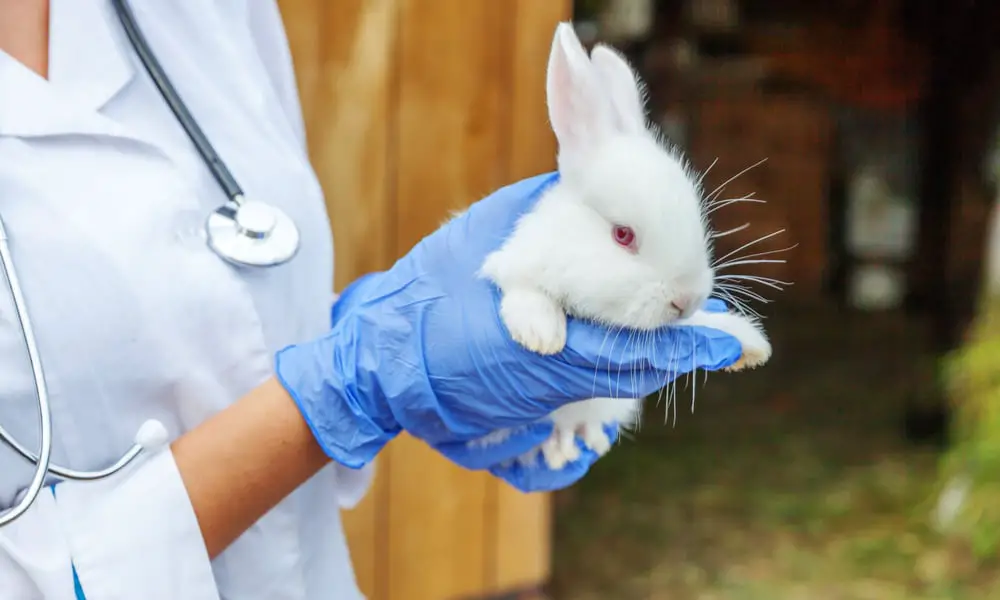Rabbits can be ill without visible symptoms because they tend to hide illness until they get really sick. Therefore, you should be aware of possible problems and give your best to prevent the most common rabbit diseases when possible.
It is crucial to provide quality food for your pet, a clean environment, required temperature and humidity conditions, and enough space for jumping and playing. Once the problem occurs, it is vital to immediately bring your long-eared buddy to the vet for necessary therapy and treatment.
Table of Contents
Most Common Rabbit Diseases
Rabbits can suffer from viral, bacterial, parasitic, and fungal infections, but sometimes you can notice non-infectious diseases in your pet. In most cases, such conditions require urgent consultation with your vet and adequate treatment.
Most common rabbit diseases |
||
| Disease | Diagnosis | Therapy |
| Viral diseases | ||
| Viral hemorrhagic disease | Symptoms and sudden death within 7 to 14 days | None (vaccine) |
| Myxomatosis | Symptoms and death within 1 to 2 weeks | None (vaccine) |
| Bacterial diseases | ||
| Snuffles (Pasteurellosis) | Symptoms | Antibiotics at least 2 to 4 weeks |
| Syphilis | Skin erosions and scabs | Treponema sp. identification under the microscope |
| Middle and inner ear inflammation | The ear and face X-rays, computed tomography | Fluid, electrolytes, and antibiotics or antifungal medications |
| Parasitic diseases | ||
| Encephalitozoonosis | Complicated | Albendazole for 2 to 4 weeks |
| Ear mites | Visualizing mites under a microscope | Vegetable oil and ivermectin |
| Skin parasites | Visual diagnostics | Prevention and regular maintenance |
| Mycotic diseases | ||
| Ringworm | Visual diagnostics | Medicated dips and specific shampoos |
| Non-infectious diseases | ||
| Overgrown teeth | Visual diagnostics, skull and face X-rays, computed tomography | Surgery to trim the teeth |
| Gastrointestinal stasis | Symptoms, blood tests, X-rays | Intravenous fluids, anti-gas drugs |
| Uterine/ovarian adenocarcinoma | Palpation, ultrasound, and radiographs | Spaying before cancer spreads |
| Kidney stones | Radiographs, stone analysis, urinalysis, stone culture, and urine culture | Enrofloxacin, metronidazole, or trimethoprim-sulfa |
| Other conditions | ||
| Torticollis (head tilt) | X-rays | Antibiotics or anti-parasitic drugs, depending on the cause, and anti-inflammatory drugs |
| Trichobezoars (hairballs) | X-rays | Fluid therapy, massage, decompression, surgery |
Viral Rabbit diseases
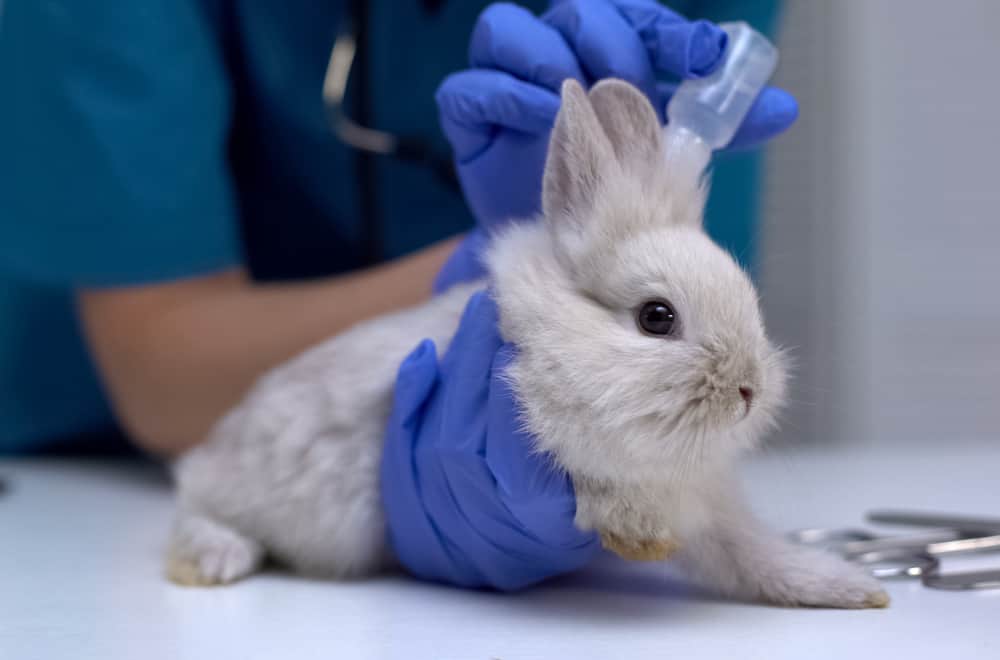
1. Viral hemorrhagic disease (rabbit hemorrhagic disease)
The hemorrhagic disease virus (rabbit calicivirus) appeared in the US in 2018 and quickly spread to both pet and wild rabbits by:
- Direct contact with infected rabbits
- Direct contact with infected rabbits’ corps and fur
- Insects (mosquitoes and flies)
- Rodents
- Contact with contaminated brushes, bedding, bowls, toys, and cages
- Ingesting infected rabbits’ products and feces
Rabbits get sick within 12 to 72 hours after exposure to the virus. In approximately 70 to 90% of cases, you can face acute pet death without previous symptoms, but sometimes you can notice some changes during 7 to 14 days, including:
- Fever over 104 F (40 C)
- Discharge from the nose and eyes
- Abnormal breathing
- Lethargy or restlessness
- Poor appetite and anorexia
- Yellow skin and eyes
- Tongue or gums blue discoloration
- Neurologic symptoms (ataxia, seizures, tremors, problems with head and limbs moving)
Unfortunately, there is no adequate therapy once this disease occurs, but you can vaccinate your adult bunny against RHDV type 2 every six months. RVHD1 appeared in the UK in the 1980s, but this strain is not noticed in the US.
2. Myxomatosis
Myxomatosis virus from the family Poxviridae is fatal for rabbits in 99% of cases. The infection focus is on the West Coast and South America, where it is transmitted by:
- Insects (fleas, mosquitoes, and fur mites)
- Close contact with infected rabbits
- Contact with bowls and bedding
- Contact with contaminated thistles and thorns
Symptoms develop within 14 days and include:
- Fever over 103 F (39.5 C)
- Skin lesions
- Red and swollen eyelids, ears, nose, lips, genitals, and rectum
- Purulent conjunctivitis
- Discharge from the eyes, nose, genital tract, and anal region
- Abnormal breathing
- Lethargy and droopy ears
- Poor appetite and weight loss
- Purple spots, lumps, or bumps on the skin
- Seizures and coma
Unfortunately, this disease is fatal within 12 hours without exceptions, and sometimes bunnies die without showing any symptoms. It is considered the most severe infectious disease in domestic and wild rabbits, but you can protect your pet by vaccinating it annually.
Bacterial Rabbit diseases
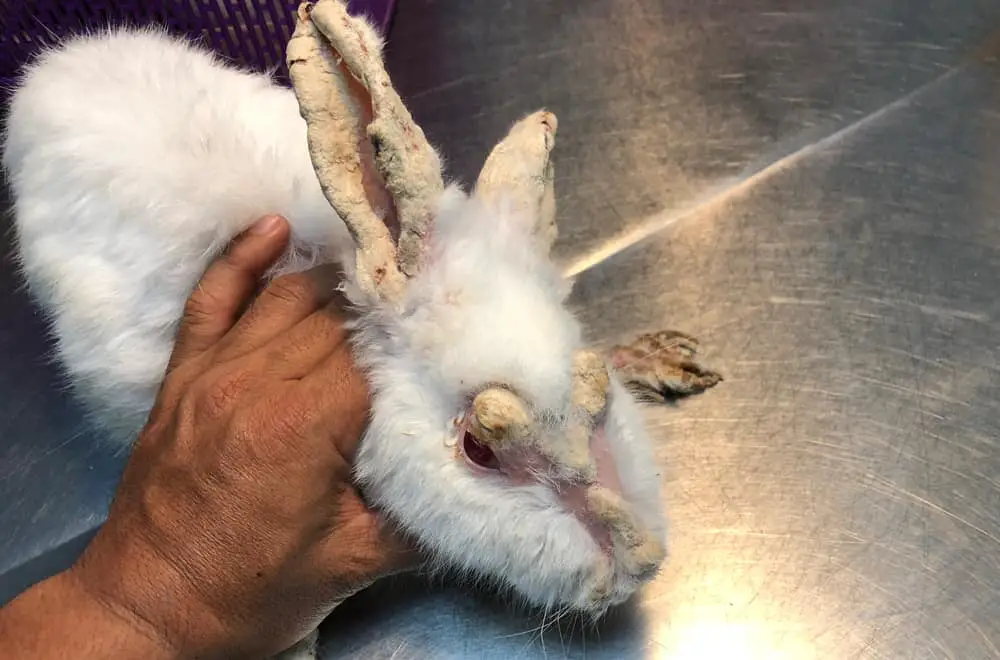
1. Snuffles (Pasteurellosis)
Pasteurella multocida is bacteria your bunny can catch by contact with an infected rabbit. The common symptoms of this endemic respiratory disease in rabbitries include:
- Eyes squinting, redness, and discharge
- Nose sneezing and discharge
- Head tilt when ears are affected
- Tooth roots abscesses
- Bones, particularly the jaw roots abscesses
- Skin abscesses
- Uterine infection
- Matted paws
Some bacteria strains can remain latent in the nasal tract until your rabbit gets stressed for any reason, resulting in a jeopardized immune system.
Infection requires at least 2 to 4 weeks of oral or injectable antibiotic therapy and sometimes surgical abscess removal.
Warning! Oral penicillin is typically fatal to rabbits, so you should avoid offering your pet medicaments without consultations with a vet.
2. Rabbit syphilis (Vent disease)
Treponema sp. causes rabbit syphilis transmitted by direct contact during birth or with infected rabbit skin. Clinical symptoms are typical and include:
- Skin erosions and scabs around the eyes, mouth, nose, ears, vulva, and perineal area
- Hair loss
The best way to identify these spiral-shaped bacteria is to find them under a microscope. The therapy with penicillin procaine benzathine SC or penicillin procaine G once a week is often successful after three doses.
Even though it is non-contagious to people, healthy rabbits are in danger, so you should isolate infected individuals.
3. Others
Other bacterial diseases occasionally diagnosed in rabbits include:
- Conjunctivitis
- Otitis (inner and middle ear inflammation)
- Abscesses
- Respiratory infection caused by Moraxella catarrhalis
- Tularemia
- Staphylococcus aureus infections
Mycotic Rabbit diseases
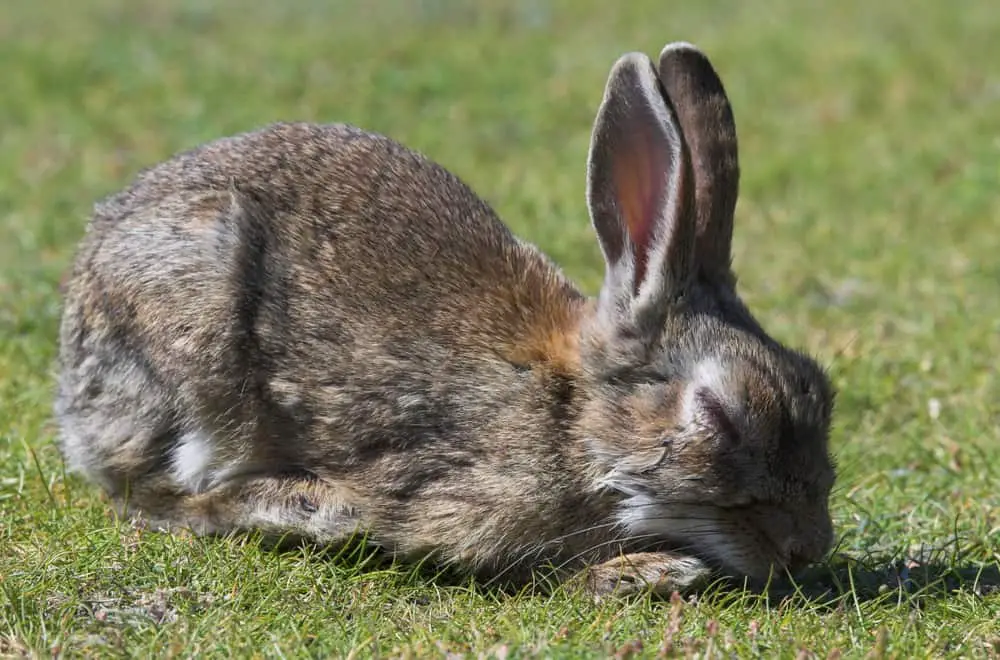
1. Ringworm
This fungal infection is common among rabbits and other mammals but is also a zoonosis, meaning it is transmitted to humans via:
- Direct contact
- Contact with the infected animal
- Contact with contaminated bedding, bowls, brushes, cages, and toys
In most cases, young animals and stressed or immunosuppressed adults have better chances of becoming infected. In the worst case, your bunny won’t show any sign of infection while spreading fungi to others. When symptoms occur, the most common are:
- Hair loss
- Scaling
- Non-itchy crusted fur lesions around the nose, eyes, and ears
The best treatment includes applying medicated dips and specific shampoos for about a month.
Parasitic Rabbit diseases
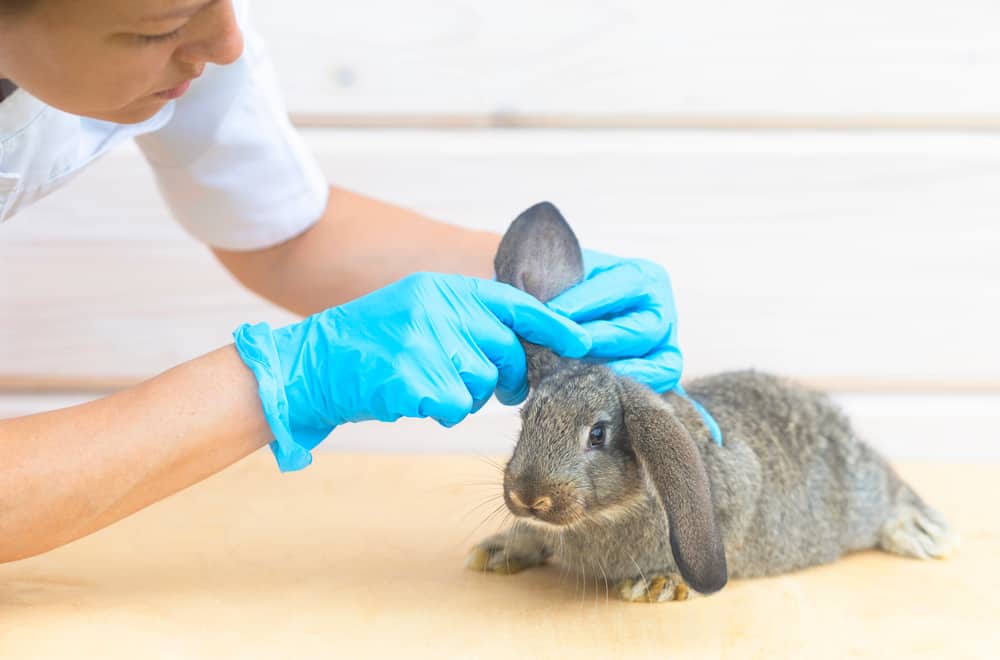
1. Encephalitozoonosis
This central nervous system disease caused by the microscopic parasite Encephalitozoon cuniculi typically exists in kits from the first day of life. They get parasites from their moms’ urine, and the disease rarely comes with characteristic clinical symptoms. Sometimes, you can notice:
- Anterior uveitis
- Dense white cataracts and twitching eyes
- Poor appetite
- Difficult walking and uncontrollable rolling over
- Neurologic signs like ataxia, incontinence, tremors, paresis, and paralysis
- Head tilt in some cases
Diagnosis is challenging because bunnies almost always have a positive antibody titer. Therapy can be tricky, but some studies show that long-term treatment of a minimum of 2 to 4 weeks with albendazole can be successful.
2. Ear mites
These tiny arachnids can cause many problems to your long-eared pet. They feed off oil and wax produced inside the ears and irritate rabbits. Typical symptoms include:
- Itching
- Scratching
- Head shaking
- Dark, crusty debris inside ears
The worst of all is that this condition leads to secondary bacterial and fungal infections when left untreated.
After diagnosing the condition by visualizing mites under a microscope, your vet will solve the problem with a few drops of vegetable oil and ivermectin. Never try to remove the scabs since it is highly painful for rabbits.
3. Skin parasites
Besides ear mites, the typical skin parasites in rabbits include:
- Cheyletiella spp. – This fur mite causes dry, scaling, and itchy skin lesions in rabbits, cats, dogs, and people. The treatment with ivermectin and medicated dips is successful.
- Fleas and ticks – Like other animals, rabbits are susceptible to flea and tick infestation. The best option is an excellent preventative, but you should be careful with some standard products since they can be fatal to bunnies.
- Fly invasion – This problem occurs in rabbits when flies lay their eggs in matted, neglected, and dirty rabbit fur. The condition is painful for bunnies since maggots eat their skin and flesh and sometimes reach the intestines.
Non-infectious Rabbit diseases
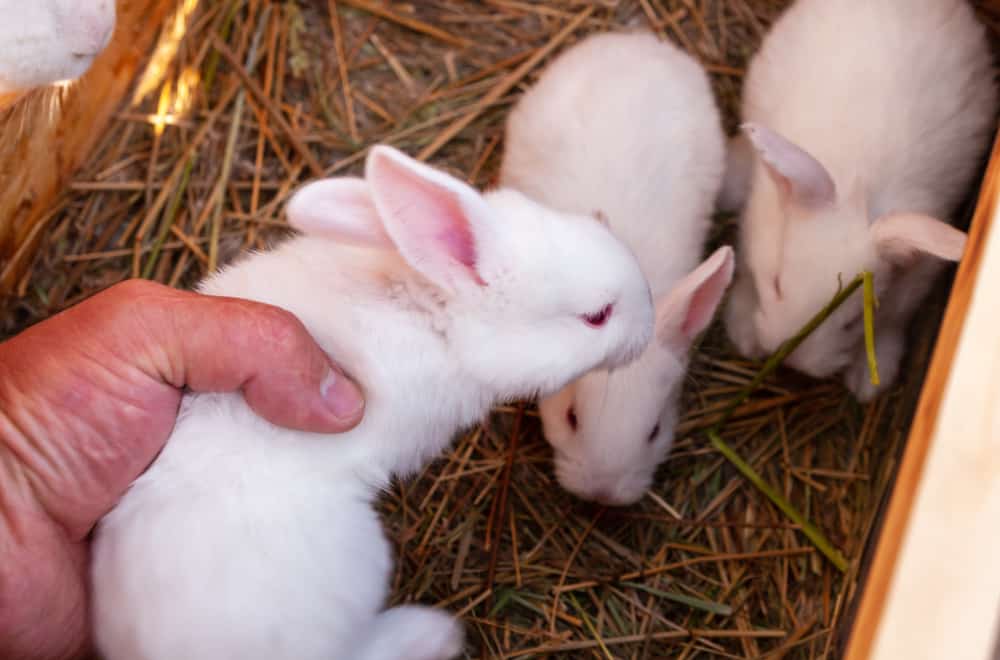
1. Overgrown teeth
Rabbits’ teeth grow throughout their life continually, and an appropriate diet enables their continuous wear. Otherwise, you will notice that your bunny’s molar teeth are overgrown, forming sharp spikes, and damaging its tongue and cheeks.
In this case, the rabbit feels pain, refuses to eat, and sometimes can’t close its mouth. Trimming a rabbit’s teeth under complete anesthesia is the only way to solve this problem.
2. Gastrointestinal stasis
This hazardous condition means a rabbit’s gastrointestinal tract dramatically slows down or stops moving because of:
- Poor diet high in carbs and fat
- Lack of exercise
- Trichobezoars (hairballs)
- Ingested foreign object
- Dental disease
- Stress
- Pain
You can recognize this potentially deadly condition when your rabbit:
- Refuse food and water
- Has no fecal production
- Shows a lack of intestinal movements
- Suffer from abdominal pain
- Grind its teeth, scratch, dig, and sit in a hunched posture
Treatment lasts about 3 to 7 days and includes:
- Rehydration
- Pain medications
- Syringe feedings
- Medications that stimulate bowel move
- Antibiotics
- Surgery in extreme cases
This condition is highly severe, and you can expect your bunny to die within 48 to 72 hours when left without therapy.
3. Kidney stones (urolithiasis, renal calculi, nephrolithiasis)
Kidney stones are hard mineral deposits formed inside the rabbit kidneys. It is typically connected with bacterial cystitis and results from a diet high in calcium.
Diagnosis includes radiographs, stone analysis, urinalysis, stone culture, and urine culture, and treatment depends on discovered culture. In most cases, your vet will prescribe enrofloxacin, metronidazole, or trimethoprim-sulfa within at least two weeks. Sometimes, surgery is the only option in this case.
4. Uterine/ovarian adenocarcinoma
Unsterilized female rabbits older than five years have a high possibility to suffer from uterine adenocarcinoma. For instance, that incidence is 80% in the Silver Marten breed. The most common clinical signs include:
- Depression
- Anorexia
- Hematuria (blood cells in urine) and dysuria (painful urination)
Your vet will diagnose this disease by palpation, ultrasound, and radiographs. An enlarged, fluid-filled uterus with cystic endometrial hyperplasia is a sure confirmation of this condition. The only treatment is ovariohysterectomy after excluding lung and bone metastasis.
5. Others
Other non-infectious diseases occasionally diagnosed in rabbits include:
- Mucoid enteritis
- Non-mucoid enteritis
- Epizootic rabbit enteropathy
- Ear calcium crystals
- Ulcerative pododermatitis
- Heatstroke
- Obesity
- Holly, mistletoe, and ivy poisoning
- Limb paralysis
- Cystic ovary
Other common health conditions
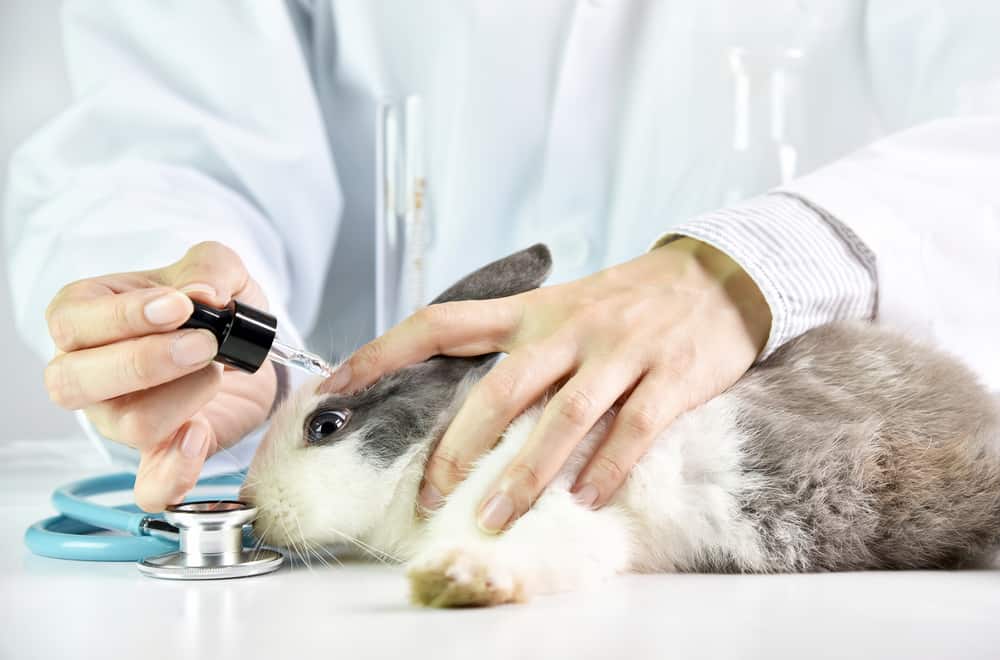
1. Torticollis (head tilt)
Tilting the head to one side is not a disease but a symptom of a pathological condition. Several causes lead to this condition, but the most common are:
- Inner bacterial ear infection, typically in lop-eared rabbits
- Parasitic brain infection caused by E. cuniculi
If your bunny has a problem with an inner ear infection, you will notice symptoms like:
- Head tilting toward the infected ear
- Lethargy
- Poor appetite
- Involuntary eye movements
- Uncontrolled rolling over
- Pus in the ear canal in some cases
Your vet will confirm this disease after noticing pus inside the inner ear by X-rays. Treatment involves long-term antibiotic therapy and anti-inflammatory drugs.
On the other hand, Encephalitozoonosis affects the central nervous system (brain and spinal cord) and causes abnormal neurologic signs, including head tilt. The only way to diagnose this disease is by blood tests and X-rays.
2. Trichobezoars (hairballs, wool block)
Hairballs (Trichobezoars) is a syndrome name people use for rabbits when they:
- Stop eating
- Become bloated with GI tract gases
- Stop passing stool
Unlike an established belief, hairballs don’t cause the food movement to slow down or cessation through the rabbits’ gastrointestinal tract. In fact, accumulated hair results from the problem when the food movement through the GI tract is decreased for some reason. In most cases, it is connected with:
- Dehydration
- Low fiber diet
- Shedding
- Decreased food intake
- The GI bacteria population change
- Obesity
As a result, dehydrated mats of hair and retained food cause GI stasis. Regardless of how dangerous this condition is, your rabbit can fully recover when treated on time.
Summary
Rabbits often have an issue with overgrown teeth, head tilt, and hairballs. Therapy is uncomplicated, but these conditions can cause severe problems when left untreated. Additionally, you should be aware of common viral, bacterial, and parasitic diseases common in bunnies and prevent them when possible.
